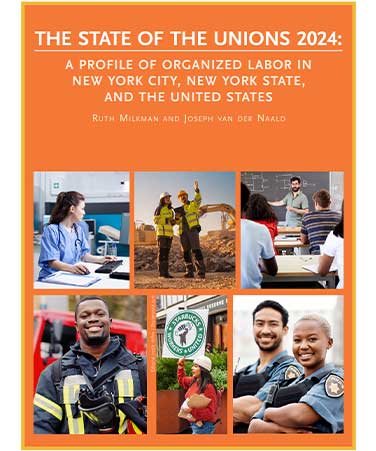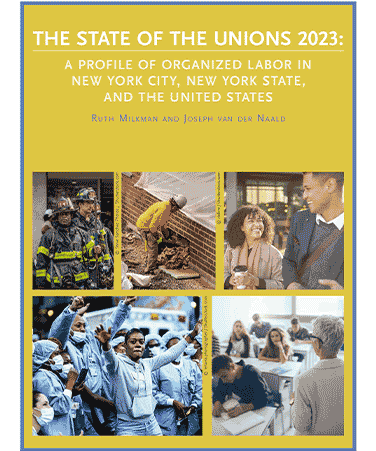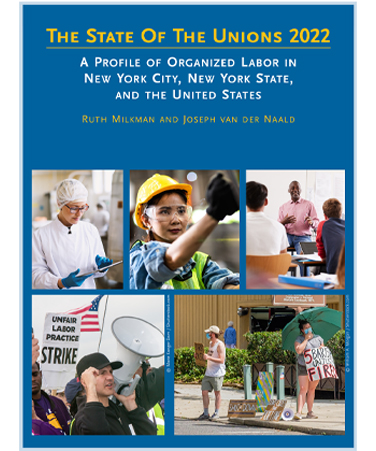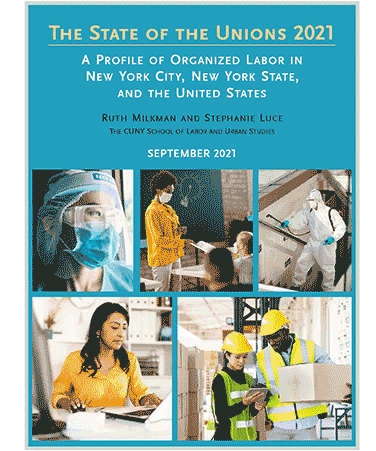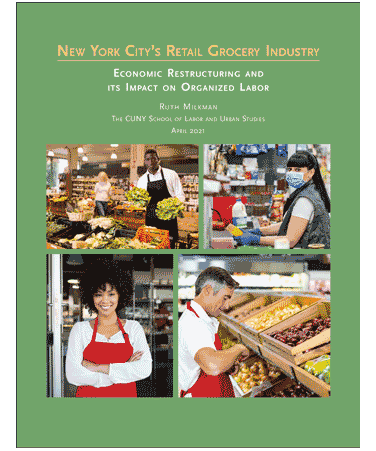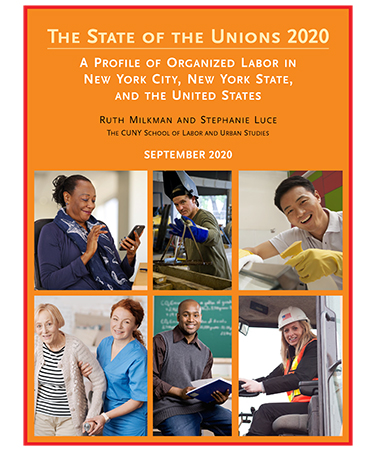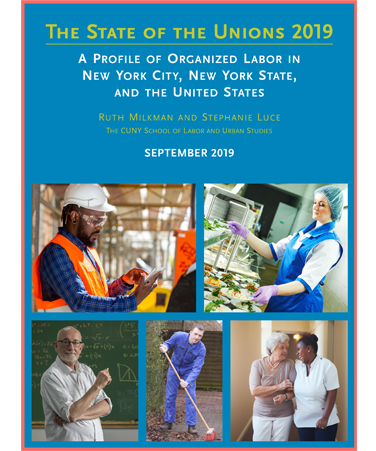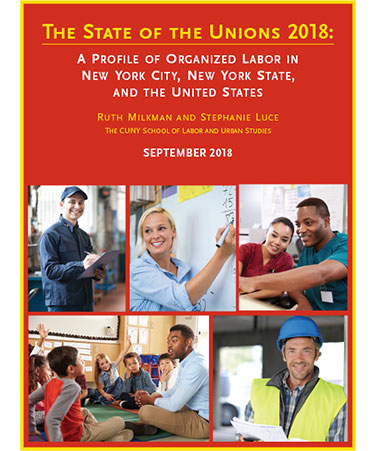The State of the Unions report, published annually by the CUNY School of Labor and Urban Studies, provides an in-depth analysis of union membership trends and labor dynamics in New York City and beyond. This comprehensive research highlights the evolving role of unions in promoting worker rights and economic justice. Explore this page to access the latest reports and gain valuable insights into the state of organized labor today.
State of the Unions 2025
Immigrant Workers Sustain New York’s Union Advantage
Immigrant workers play an outsized role in sustaining New York’s union strength, according to The State of the Unions 2025: A Profile of Organized Labor in New York City, New York State, and the United States. The report documents how citizenship status, length of time in the U.S., and sector of employment help shape unionization rates among immigrants. In New York City, foreign-born workers are slightly more likely to be union members than the U.S.-born, with naturalized citizens exhibiting the highest unionization levels. For organized labor overall, however, the widely publicized victories at companies like Starbucks and Amazon are not representative of overall trends, with private-sector union density remaining much lower than in the public sector.
State of the Unions 2024
Tight Labor Market and Growing Union Popularity Drive Growth In Organizing and Wins
The CUNY School of Labor and Urban Studies’ latest annual report on unionization patterns shows that private-sector union organizing efforts continued to increase across the country over the last year. The report documents that growth in union election petitions since 2020 has reversed a decade of decline, reaching a level not seen since 2015. Current union election win rates outpace any since 2005. Unions are both petitioning for more representation elections and winning more of those elections, with over three-quarters of all private-sector organizing attempts ending in union victories in 2023-24. Additionally, polls show increasing support for unions among Americans, particularly the young.
State of the Unions 2023
New Study Reveals Upsurge in Unionization
This report released by the CUNY School of Labor and Urban Studies, State of the Unions 2023: A Profile of Organized Labor in New York City, New York State, and the United States, is a part of an annual publication series, documents recent trends in unionization patterns.
The overall level of unionization in both the City and State has been roughly double the national rate over the past two decades. But recently, union density has fallen more in New York City and New York State than in the United States as a whole. In the mid-2010s, both the City and State rates steadily hovered around 24 percent, but they began to fall after 2017. By 2022–23, only 17.7 percent of all wage and salary workers residing in the five boroughs of New York City, and 20.2 percent of those in the state, were union members.
This year’s report includes a special feature guest authored by CUNY’s National Center for the Study of Collective Bargaining in Higher Education and the Professions at Hunter College, It analyzes the recent uptick in organizing and strikes among student-workers and faculty in higher education since January 2022.
State of the Unions 2022
New Study Reveals Growth in Private-Sector Union Organizing, With New York City Playing a Leading Role.
New York City leads the recent uptick in private-sector union organizing at companies like Starbucks and Amazon. A new report released by the CUNY School of Labor and Urban Studies, State of the Unions 2022: A Profile of Organized Labor in New York City, New York State, and the United States, analyzes new union membership and union election wins across the nation’s major cities. The report also details the geographic, demographic, and occupational makeup of union membership in New York City, New York State, and the nation.
State of the Unions 2021
Data Shows the Pandemic’s Employment Impact Was Smaller for Unionized Workers, Especially Unionized Women and Mothers
The COVID-19 pandemic and the resulting lockdowns generated vast job losses across the United States. The New York City metropolitan area, where the pandemic’s impact was felt earlier than elsewhere in the country, suffered severe job losses in 2020. The decline in employment among women workers was greater than among men — in sharp contrast to the Great Recession, which hit men’s employment harder. A new report released today by the CUNY School of Labor and Urban Studies, State of the Unions 2021, A Profile of Organized Labor in New York City, New York State, and the United States, presents data on gender, union membership, and job losses in the COVID-19 economic downturn on the New York metropolitan area labor market. The report also includes an in-depth look at the geographic, demographic, and occupational makeup of union membership in New York City, New York State, and the nation, updating previous reports in this annual series.
New York City’s Retail Grocery Industry 2021
Economic Restructuring and its impact on Organized Labor
This report by SLU Distinguished Professor Ruth Milkman analyzes in detail the impact on New York City supermarket workers and their unions of economic restructuring and corporate concentration in the retail grocery industry. As of 2020, the United Food and Commercial Workers (UFCW) union represented over 35,000 workers in the New York area, the vast majority of them employed in supermarkets. But with the entry into New York City of nonunion grocers like Trader Joe’s and Whole Foods (now owned by Amazon), and the growth of grocery sales among nonunion discount stores like Target and (mostly nonunion) drug stores like CVS, Rite Aid and Walgreens, the market share of unionized supermarkets has declined. Mergers and acquisitions, and the entry of multinational firms and private equity into the New York market, have further changed the landscape.
State of the Unions 2020
New Study Illustrates the Impact of COVID-19 Pandemic on New York City Workers and Union Members
The 2020 COVID-19 pandemic has had a devastating impact on labor markets worldwide. In the U.S., millions of workers have been furloughed or laid off in both unionized and non-union sectors. New York is no exception. In the early phases of the pandemic, New York City was the national epicenter due to its high population density, extensive reliance on public transportation, high rates of poverty and poor access to health care. The initial delays in responding by government officials, as well as the limited availability of testing, compounded these problems. An estimated 6,000 working age (18-64) New Yorkers have died from COVID-19, among nearly 24,000 in the city’s population. Although unionized workers were less likely to lose their lives to the virus than the general workforce, for some unions and sectors the impact has been devastating. CUNY SLU’s annual State of the Unions 2020, A Profile of Organized Labor in New York City, New York State, and the United States, presents data on confirmed COVID cases and deaths, as well as layoffs and furloughs, among members of some of New York City’s largest unions as of July 2020, and analyzes the pandemic’s effect more broadly on New York’s labor market.
A Transit Workers Survival Story
And for an in-depth look at how the pandemic is impacting union workers, read this piece on Terence Layne, an MTA bus driver and former SLU student.
State of the Unions 2019
New Study Shows that Organized Labor Remains Far Stronger in New York City and State than in the Nation, but Union Erosion Contributed to Disproportionately Low-Wage Job Growth
Ten-years after the Great Recession of 2008, employment has rebounded in New York City and New York state (the unemployment rate was 4.0% for the state in July 2019). However, this job growth has been disproportionately concentrated in low-wage industries, especially in the private sector, according to a report released by the CUNY School of Labor and Urban Studies. The report, State of the Unions 2019, A Profile of Organized Labor in New York City, New York State, and the United States, conducted annually, reveals that in recent decades, losses in union membership have been disproportionately concentrated in the private sector, a trend that accelerated after the Great Recession. By contrast, in the public sector, union density has been relatively stable in the City, while declining slightly over the past few years in the U.S. and New York State.
State of the Unions 2018
New study discusses how organized labor in the United States has suffered a sharp decline in numbers and influence in recent years.
In addition to the challenges of the prolonged recovery from the Great Recession, anti-union groups have launched aggressive attacks on public-sector collective bargaining rights. Organized labor remains much stronger in New York City and State than in the nation as a whole; indeed, overall unionization rates in those jurisdictions have been fairly stable over the 2010s, in contrast to steady erosion on the national level.
